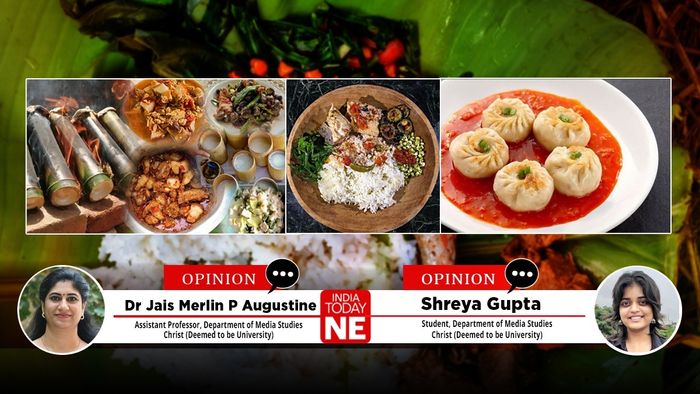Taste of Home: North Eastern Migrants and Flavours in Bengaluru
North Eastern migrants are reshaping Bengaluru's culinary scene with their traditional dishes. This cultural exchange is enhancing the city's food diversity and community ties

- Oct 22, 2025,
- Updated Oct 22, 2025, 12:03 PM IST
Bengaluru, home to a growing population of North Eastern migrants, offers a unique perspective on what it means to belong in a sprawling urban landscape. While the city is often celebrated for its tech corridors and skyscrapers, the human side of urban life is most vividly expressed not through glass towers or traffic-choked roads, but through food—the aroma of home that comforts, connects, and preserves the identities of people far from their native states. For many North Eastern students and workers, discovering a familiar taste in the city is the first anchor of belonging in an otherwise unfamiliar urban environment. This becomes particularly significant on World Cities Day-October 31- a day that celebrates inclusive urban life and reminds us that cities are defined not just by infrastructure, but by the people who inhabit them and the cultural ties they carry.'
Food as a Map of Belonging
For students from the North East, navigating Bengaluru’s sprawling cityscape can be overwhelming. Streets lined with momo stalls, darshinis serving dosas at lightning speed, and small eateries offering regional delicacies provide more than convenience—they offer emotional anchors and a sense of belonging.
Ankur Das, a 19-year-old first-year student from Assam at Christ University, recalls the relief of discovering Axomi, an Assamese eatery tucked away in Koramangala. “It felt like my mom’s kitchen,” she says. Similarly, Riya, another student, shares, “Even the way people sit around and eat late at night makes me feel less alone.” For many, discovering a taste of home becomes the first way to orient themselves in a sprawling, unfamiliar city. These food spots act as cultural waypoints, helping migrants navigate not just streets, but the emotional geography of urban life.
Nostalgia on a Plate for Workers
Food is equally significant for Bengaluru’s informal workforce, who often face long hours and low wages. Raju Yadav, 36, a small-scale jewellery seller from Bihar, finds comfort in litti-chokha stalls. “It reminds me of home and makes me feel I belong here,” he says.
Lakshmi Devi, 48, a domestic worker from Uttar Pradesh, grew up eating millet-based meals. “We had jowar roti and spicy chutneys at home. In the homes I work in now, it’s mostly bread and pasta. Sometimes I visit a small mess near Majestic to eat bedmi puri—it’s like going home for an hour,” she adds. For workers like Lakshmi, traditional foods preserve rural identities and act as a subtle form of cultural resistance in a rapidly urbanising city.
Chefs Carrying Memories
For professional cooks, food is both livelihood and identity. Mohammed Sameer, 28, a sous-chef from Lucknow, explains, “When I cook Awadhi-style biryani for staff meals, I feel I’m sharing a piece of my city with others. I feed the city, and it feeds my memories.” In Bengaluru’s cosmopolitan kitchens, chefs encounter cuisines they never imagined preparing, yet each dish becomes a thread connecting them to their roots. The act of cooking regional dishes offers both creative satisfaction and emotional grounding, allowing chefs to carry a piece of home into the city’s culinary landscape.
Sharing Meals, Building Bridges
Even retirees find social connections through food. Ramesh Chatterjee, 68, who moved from Kolkata, recalls missing home-cooked Sunday meals. “When my neighbour invited me for bisi bele bath and kosambari, I realised a new city can offer new tastes to love,” he says. Sharing meals becomes a way to make friends, form communities, and integrate into urban life. Food also facilitates cross-cultural understanding. College students, informal workers, and retirees often find themselves exchanging recipes, tips, and stories. A North Eastern student teaching a local vendor how to make momos, or a Bihari worker sharing litti-chokha with a colleague from Karnataka, turns food into a bridge across regions and backgrounds.
Bengaluru’s Soul Served on a Platter
From VV Puram’s bustling food street to hidden Assamese and other North Eastern eateries in Koramangala, Bengaluru’s foodscape reflects the city’s human story. Students, workers, professionals, and elders from the North East carry their regional heritage while creating new urban traditions. For migrants, food is more than sustenance—it is a connection to home, culture, and memory. Eating familiar dishes like momos, thukpa, or Assamese pitha helps them navigate city life, reclaim their roots, and preserve identity. In a city far from their native states, each meal becomes a reminder of belonging, comfort, and community.